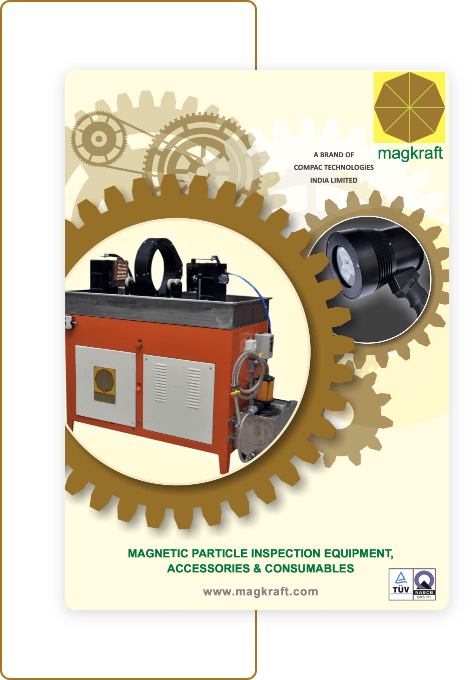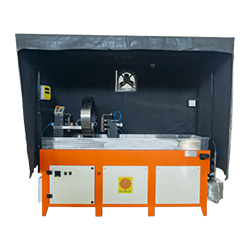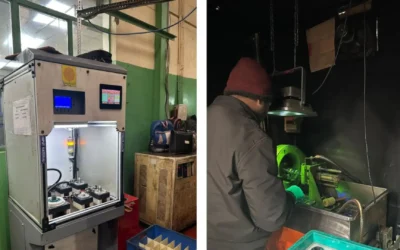Non-destructive testing (NDT) is critical in ensuring the integrity and reliability of materials and components across various industries. However, like any technical field, NDT has challenges that can impact inspection outcomes and efficiency. In this article, we'll...

The cam shaft needs to be magnetized in two directions perpendicular to each other. A circular magnetic field is used to detect longitudinal flaws in the part.
The circular magnetic field is generated by passing a current through the length of the cam shaft.
Calculation of headshot current is done as per the formula given in ASTM standards.
Head Shot Current = 20 X Diameter(mm)
In the above formula, the diameter should be taken as the diameter of the shaft portion.
A longitudinal magnetic field required for the detection of transverse defects is generated by using an encircling coil.
Formula for calculation of coil current

In the above formula, the diameter should be taken as the average diameter of the cam shaft. The average diameter can be calculated by the following formula.
![]()
A horizontal bench-type machine is used to perform magnetic particle testing on cam shafts. Cam shaft is placed on the steady rollers fitted on the head & tailstock of the machine. A pneumatically operated arrangement is used to clamp the cam shaft from both ends. Pneumatic clamping ensures that there is no sparking when a high current is passed through the cam shaft. The use of braided copper pads is also recommended to eliminate arcing sparks.
Conventional Technique
A two vector PLC based bench type magnetic crack detector machine is used to perform testing on the cam shafts.
Testing Procedure for conventional machines
- Clean up & dry the cam shaft’s surface before inspecting.
- The cam shaft is placed on the steady rollers.
- Now apply the magnetic solution bath to the cam shaft.
- Press the ‘Cycle Start’ button.
- The cam shaft automatically gets clamped.
- Stop the flow of the bath.
- Now, the current passes through the cam shaft.
- It shows up on the digital metering unit.
- The cam shaft automatically gets de-clamped.
- Inspect the cam shaft under UV light for longitudinal defects. Rotate on steady rollers.
- Now, again apply bath to the job.
- Press the ‘Cycle Start’ button.
- Stop the flow of the bath.
- Now the current passes through the coil.
- It shows up on the digital metering unit.
- Inspect the cam shaft under UV light for transverse defects. Rotate on Rollers
- Demagnetize
Multidirectional Technique
In this tailor-made machine, the coil is automatically moved using pneumatic actuators. Since the length of the housing is short, the coil is moved aside to facilitate the loading of the part.
Testing Procedure for Multidirectional machines
- Clean up & dry the cam shaft’s surface before the inspection
- Place the cam shaft on the steady rollers.
- Now apply a bath to the cam shaft.
- Press the ‘Cycle Start’ button.
- The cam shaft will automatically get clamped & the Coil will come into position
- Stop the flow of the bath.
- Now the current will pass through the cam shaft & the coil in multidirectional mode.
- It will show up on the digital metering unit.
- The cam shaft will automatically get de-clamped.
- Inspect the cam shaft under UV light for defects in all directions. Rotate on rollers.
- Demagnetize
suitable products
Standard MPI Machines
Engineered for precision and efficiency, the Standard Bench Type Magnetic Particle Testing Machine is suitable for entry level testing.
PLC Controlled MPI Bench
With PLC Controlled bench type Magnetic Particle Inspection Machine, you can accurately control the process parameters for reilable results.
Multidirectional MPI Bench
The ultimate solution for robust non-destructive testing, this machine offers multi-directional magnetization for inspection in all directions in one shot..
Demagnetizers
Demagnetizers stand as a key tool in maintaining excellence in production, with the flexibility to handle different materials and magnetism levels, coupled with energy-efficient and user-friendly design.

DIVE DEEPER: GET YOUR HANDS ON OUR PRODUCT BROCHURE!
Explore More, Discover Better!
- In-Depth Details
- Product Insights
- Expert Recommendations
Download Our Brochure Now!
Blogs
Exploring the Applications of Eddy Current Testing: A Focus on Magkraft’s Offerings
Eddy Current Testing (ECT) is a widely used non-destructive testing (NDT) technique to inspect conductive materials for surface and subsurface defects. With its versatility and effectiveness, ECT finds applications across various industries, including aerospace,...
Cost-Effectiveness and Safety: The Dual Benefits of Using Magnetic Crack Detectors in Your Operations
Cost-Effectiveness and Safety: The Dual Benefits of Using Magnetic Crack Detectors in Your Operations In the modern industrial landscape, where safety and cost management are paramount, non-destructive testing (NDT) tools like magnetic crack detector become critical....







